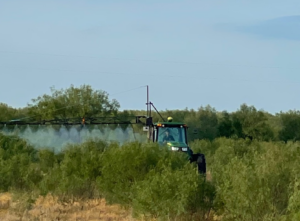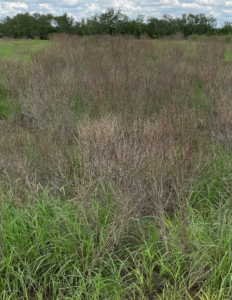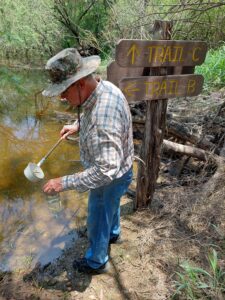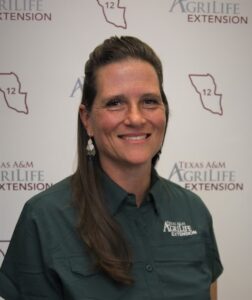The Texas A&M AgriLife Extension Service offers a diverse array of educational programs, activities, and resources. These range from self-study activities to programs that you can attend. No matter the name, Extension programs are based on objective, research-based, practical information that you can use today. Listed below are the departments, programs, units and institutes that make up the Texas A&M AgriLife Extension Service.
Opportunities to Learn with
McMullen County AgriLife Extension
- We host two Private Pesticide Applicator classes per year. If you want to get a license to purchase controlled brush control chemicals, this class is for you!
- Do you need CEU‘s? Call us to get on the mailing list to be notified when a class is scheduled.
- Water Well testing is offered twice per year; March and October. $15 per sample
- Beef Reproduction Workshop in May of each year is a multi-county, hands-on opportunity to learn to palpate for pregnancy determination, along with a full day of usable and easy to understand information.
What’s Happening?
Fenceline Mixed Brush Trial
The fenceline applied research project is in conjunction with Bayer Crop Sciences. We are looking at Individual Plant Treatment (IPT) applications on a variety of mixed brush with Invora and 5 Invora mixes compared to Surmount at 2% (7 treatments total).
We sprayed during the drought, although plants were in good condition, soil moisture measured zero, and soil temperature measured high.
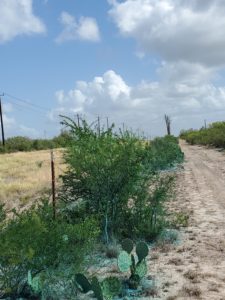
Before!
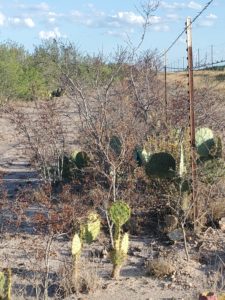
Defoliation at two weeks!
Running Mesquite Trial
Treatments were established in August 2022. Five (5) treatments with Corteva AgriScience using Sendero, Sendero plus Remedy Ultra at three different rates, and Sendero with a test chemical were applied ground broadcast.
Brush was sprayed at late in the season, after significant drought conditions but received about 6 inches of rain within two weeks after application.
Mosquito Study
Summary
Dr. William Sames, a retired Army Medical Entomologist and now an independent Medical Entomology Consultant, contacted me a couple of years ago about helping him collect mosquitoes in McMullen County as part of his study to document the mosquito species in 27 South Texas counties. As you drive towards the Rio Grande Valley and coast, the number of species per county increases.
Objective
Document at least 25-35 species of mosquitos per county in 27 South Texas Counties
Materials and Methods
Mosquito larvae collected in various habitat, during different seasons and temperatures. Larvae are sorted and identified.
Results and Discussion
So far, he has documented 24 species in McMullen County. They look different, have different habitat and food preferences, and some live only in the winter and can even live under ice!
Som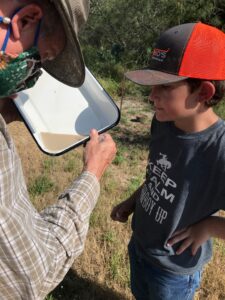 e mosquitoes are very common and easy to collect. Usually, these are associated with humans and as larvae can live in all sorts of containers, around leaking faucets, broken water pipes, the ground pools caused by overflowing water troughs or in natural occurring habitats. They will feed on mammals, but birds are preferred. However, when a bird isn’t handy, a human or other animal will do just fine. Many of these vector diseases such as West Nile virus.
e mosquitoes are very common and easy to collect. Usually, these are associated with humans and as larvae can live in all sorts of containers, around leaking faucets, broken water pipes, the ground pools caused by overflowing water troughs or in natural occurring habitats. They will feed on mammals, but birds are preferred. However, when a bird isn’t handy, a human or other animal will do just fine. Many of these vector diseases such as West Nile virus.
Other mosquitoes occur only after heavy rains, live in very shallow water along the edge of ponds or rivers, or live in tree holes. The ones associated with heavy rains are super aggressive and attack humans, livestock, and anything else with blood. They are usually not associated with disease transmission. These tend to be the most colorful. Some are white, some are orange, and some sport metallic gold, purple, blue, or green.
The ones living along the edge of ponds or rivers are split as to their tastes for blood. Occasionally, some will feed on humans, but many feed only on reptiles, amphibians, and worms. Then there are the ones whose larvae breath through the roots of submerged aquatic plants such as cattails. They feed on anything night or day.
The tree hole mosquitoes are diverse with some of the human associated varieties also using this habitat. After rains, a hole in tree may fill with water and eggs laid in the tree hole will hatch and develop. Some of the species will feed on birds and mammals and some will only feed on birds. In South Texas, oaks and hackberries are the best place to look for tree hole species.
Then there is the mosquito that as a larva eats other mosquito larvae. As an adult it does not take blood meals but consumes carbohydrates from nectar or other plant juices. There are 2 species in South Texas, but their distribution is not well documented, and Dr. Sames has not collected them in McMullen County. In the wild, they are found in tree holes especially those of oaks or hackberries. They can also be found in tires or plastic containers that fill with rainwater and are under the cover of trees.
Conclusions
Evaluations will be concluded in 2023 and a written report will be available in 2024
Acknowledgments
Appreciation is expressed to landowners Gina Langley, Marty Soward, TR Lansford III DVM, and McMullen County for allowing us to set traps and collect.
